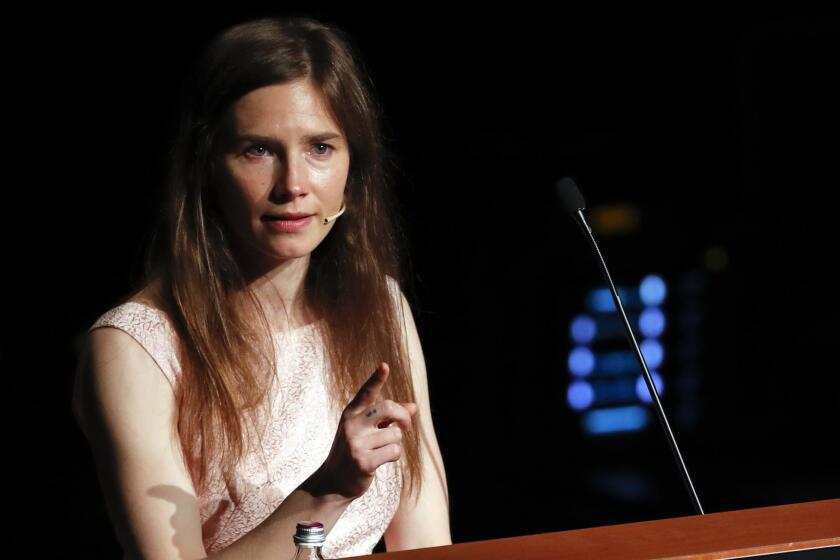Roaming Wild in the Land of Linguistics
- Share via
“The Hesse wolf-child; the Irish sheep-child; Kaspar Hauser, the first Lithuanian bear-child; Peter of Hanover; the second Lithuanian bear-child; the third; the Karpfen bear-girl; Tomko of Zips; the Salzburg sow-girl; Clemens, the Overdyke pig-child; Dina Sanichar of Sekandra; the Indian panther-child; the Justedal snow-hen; the Mauritanian gazelle-child; the Tehran ape-child; Lucas the South African baboon-child and Edith of Ohio.”
That peculiar catalogue, befuddling on its surface, compiles some of the past seven centuries’ 50 or more documented “wild children”--children raised outside the bounds of human influence, sometimes by animals.
To that list add Genie, an adolescent girl found in 1970 in San Gabriel Valley’s own Temple City, who had spent most of her life locked in a closet, essentially immobile and deprived of all but the basest contact with other beings.
In another publication, Genie’s tragic story would make for a few pages of gripping bathos.
In the New Yorker, Genie’s tale is merely a trail upon which readers take an extraordinary trek into the landscape of linguistics, in search of a philosophic grail: “What makes us special as a species? What part of our essential humanity is expressed in our ability to communicate with language?”
As it happens, Genie was born in 1957, the year Noam Chomsky published his landmark “Syntactic structures.” Thirteen years later, when authorities took this virtual blank-slate of a girl into protective custody, people who studied language and its origins had already split into two camps.
Anti-Chomskians believe that similarities in vocabulary and pronunciation among various languages suggest that all languages evolved from a common “protolanguage.”
Pro-Chomskians share the master linguist’s belief that language skills are innate and, at their deepest structural levels, languages are identical; that a group of children raised on an island with no language would in a generation or two, create one.
In the first of two installments, “A Silent Childhood,” Russ Rymer puts the linguistic debate into historical context, explaining how it has been affected by studies of other wild children and why researchers saw Genie as so valuable.
The story is rich with curiosities. The key researcher studying Genie, for example, noted the girl’s extraordinary nonverbal communications skills. One afternoon the researcher took Genie for a walk. A woman inexplicably stopped her car in traffic, emptied her plastic purse and jumped out and handed the purse to Genie, unaware that the girl’s isolation had fostered an odd longing for the texture of plastic.
Beneath the narrative, though, is an intriguing complexity of other issues.
For example, was Genie less than human when she was locked up? And how do researchers ethically balance the potential for understanding human nature that such a rare case offers with Genie’s rights to achieve her fullest potential as a member of her species?
Rymer leaves us hanging, longing for scientific insight into our own humanity, and hoping that Genie finds love or happiness or cognition or whatever it is that will make her more truly one of us.
REQUIRED READING
Law firms last year grossed more $100 billion--not including what companies spend on their own legal departments. Since 1971, the number of attorneys has tripled, to 780,000, Business Week reports in its April 13 cover story.
Now, “executives fear the U.S. legal system is crippling America’s ability to compete in the global marketplace.”
But reforming the legal system also has its perils. Arbitration, for example, will allow companies to slip out of the public eye and possibly ignore the public interest.
NEW ON NEWSSTANDS
Americans have become so conversant with filmmaking that Ladies’ Home Journal or Field & Stream could probably feel free to throw in a casual reference to morphing.
But only those deeply immersed in the biz will be able to decipher most of what’s in On Production.
Not all articles in the first issue of this slick and well-written trade journal brim with techno-jargon. Except for a quick reference to choosing “Cinemascope instead of 1:85,” the cover story on “Basic Instinct” director Paul Verhoeven might have appeared in Movieline or Premiere.
But this magazine’s core is nuts-and-bolts features on electronic editing, facilities, computer graphics, production design, sound and the like.
The goal of On Production, according to Executive Editor and Publisher Howard Kunin’s first column, is to help readers “make better movies, shows, commercials--or at least to offer our readership the opportunity to read about those who do just that.”
(On Production, $15 for five issues, one year, 17337 Ventura Blvd., Suite 226, Encino, Calif. 91316. (818) 907-6682.)
NEWSSTAND NEWS
It would seem to be final. Punch, a British institution since 1841, has gone belly up. According to the Associated Press, the final issue of the humor weekly was published Wednesday. The cover shows a dejected Punch stumbling into the sunset with his friend Judy and dog Toby.
SHREDDER FODDER
It is reasonable for Reason magazine to follow its libertarian ideals and argue against governmental bans on cigarette ads. But why does Associate Editor Jacob Sullum sneer at private groups such as the American Medical Assn.--”Big Mother” he calls them--for protesting the cynical and sickening Joe Camel ad campaign?
He can hardly object too loudly to citizens’ exercising their First Amendment right to grouse and vent their disgust. Instead, he pooh-poohs the notion that such cutesy cartoon ads actually influence kids: “Big Mother can’t point to solid research demonstrating that the Joe Camel campaign (or any cigarette advertising) increases smoking among children (or anyone).”
For the sake of this generally excellent magazine, let’s hope Sullum’s doubts about the efficacy of advertising are read with a grain of salt by the companies that buy space to promote their products. Such as the multinational that sunk some big bucks into a full-page, full-color ad in the same issue that reads: “Philip Morris Doesn’t Want Kids to Smoke.”
By the way, the April edition of the Mayo Clinic Health Letter reports the results of a University of Michigan study of 99 publications from 1959 to 1986: “Researchers found that magazines with cigarette ads are far less likely to publish articles on the risks of smoking, compared to magazines that refuse money from cigarette makers.”
More to Read
Sign up for our Book Club newsletter
Get the latest news, events and more from the Los Angeles Times Book Club, and help us get L.A. reading and talking.
You may occasionally receive promotional content from the Los Angeles Times.









